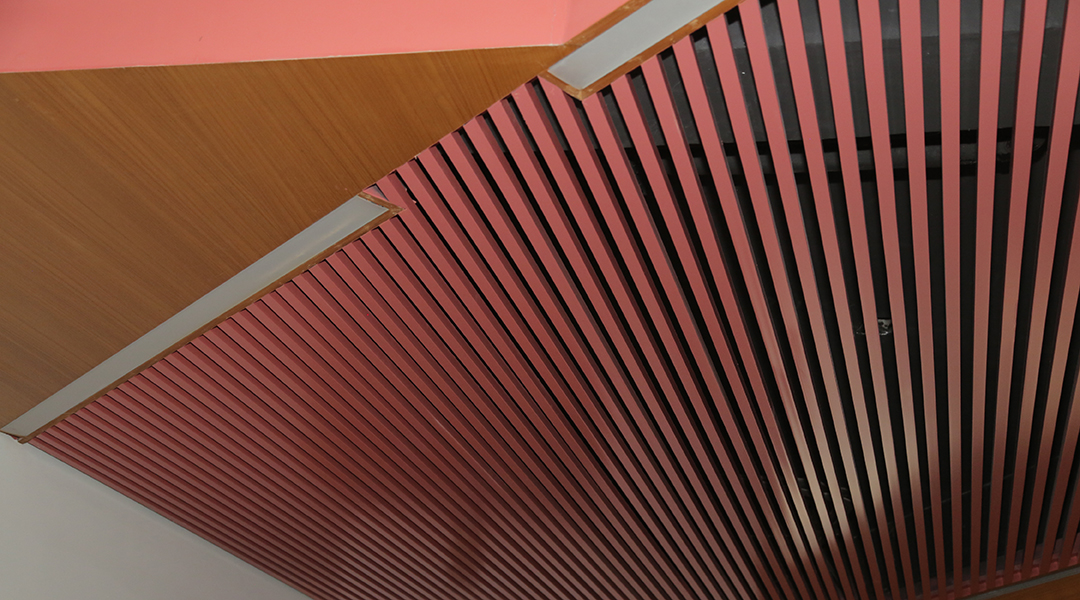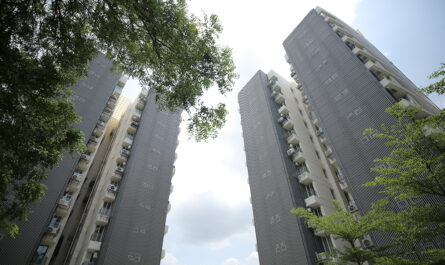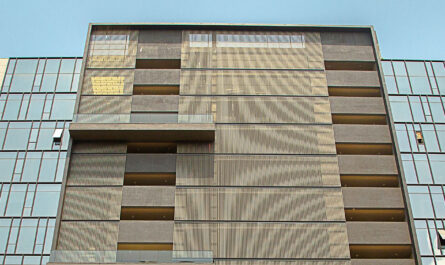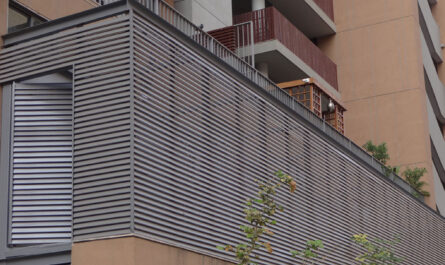The finish applied to architectural louvers is far more than a simple color choice—it represents a critical decision that impacts performance, longevity, maintenance requirements, and visual appeal. Whether designing a commercial facade, institutional building, or high-end residential structure, the right finish transforms ordinary louvers into striking design elements while providing essential protection against environmental stressors. This comprehensive guide explores the technical aspects and aesthetic considerations of louver finishes to help architects and builders make informed decisions for their next project.
Why Louver Finishes Matter
Protection Against the Elements
Architectural louvers face constant exposure to challenging environmental conditions:
- UV radiation that breaks down materials over time
- Moisture from rain, snow, and humidity
- Salt exposure in coastal environments
- Pollutants and industrial fallout in urban settings
- Temperature fluctuations causing expansion and contraction
The right finish creates a critical barrier that determines whether louvers will maintain their appearance and functionality for years or deteriorate prematurely.
Visual Impact and Design Integration
Beyond protection, finishes establish:
- Color cohesion with overall architectural language
- Light reflectivity affecting building appearance throughout the day
- Texture that contributes to the tactile experience of the building
- Design differentiation that sets the project apart
Types of Louver Finishes
Powder Coating: Versatility Meets Performance
Powder coating has revolutionized architectural finishes through its combination of durability, color options, and environmental benefits.
How Powder Coating Works
Unlike liquid paint, powder coating involves:
- Electrostatically charged dry powder application
- Heat fusion to create a continuous protective film
- Single-process application creating thicker, more uniform coverage
Performance Benefits
- Exceptional Durability: Resists chipping, scratching, and fading
- Environmental Advantages: Contains no solvents, with minimal VOCs and waste
- Thickness Control: Typically 2-3 mils (50-75 microns) for optimal protection
- Edge Coverage: Superior protection of edges and corners
Color and Texture Options
Metalium’s powder coating options include:
- Standard RAL and custom color matching
- Metallic, textured, and specialty finishes
- AAMA 2604 (medium performance) and AAMA 2605 (high performance) formulations
- Antimicrobial formulations for healthcare and educational settings
Anodizing: The Premium Aluminum Solution
For aluminum louvers, anodizing offers an integrated finish that becomes part of the metal itself.
The Anodizing Process
This electrochemical process:
- Creates a controlled oxidation layer
- Integrates color within the oxide structure
- Permanently seals the surface
Performance Characteristics
- Unmatched Hardness: Harder than the base aluminum itself
- Color Stability: Exceptional resistance to UV degradation
- Natural Appearance: Maintains metallic character with depth and luster
- Low Maintenance: Self-healing minor scratches through natural oxidation
Anodizing Specifications
Metalium offers anodizing options including:
- Class I (0.7+ mil) and Class II (0.4-0.7 mil) thicknesses
- Clear, champagne, bronze, black, and custom colors
- Matte, satin, and bright finishes
- Dual finishing for different interior/exterior appearances
PVDF Coatings: Premium Weather Resistance
Polyvinylidene fluoride (PVDF) coatings represent the gold standard for architectural applications requiring exceptional color retention and chalking resistance.
PVDF Technology
These fluoropolymer coatings feature:
- 70% or higher PVDF resin content
- Advanced pigment technology
- Multiple coat systems for maximum protection
Weather Resistance
PVDF systems excel in:
- Color Retention: Minimal fade even after decades of exposure
- Chalk Resistance: Maintains surface integrity in harsh environments
- Chemical Stability: Outstanding resistance to acid rain and pollutants
- Flexibility: Accommodates thermal expansion without cracking
Specification Standards
Metalium’s PVDF finishes meet:
- AAMA 2605 performance standards
- 30+ year performance warranties
- Custom formulations for extreme environments
Specialized and Emerging Finishes
Beyond traditional options, innovative finish technologies offer new possibilities:
Wood-Look Finishes
- Sublimation processes creating realistic wood grain appearance
- Benefits of metal with warmth of wood
- No maintenance or refinishing requirements
Anti-Graffiti Coatings
- Sacrificial or permanent protection systems
- Easy cleaning of vandalized surfaces
- Integration with standard finish systems
Photocatalytic Finishes
- Self-cleaning technology utilizing titanium dioxide
- Air-purifying properties breaking down pollutants
- Enhanced by natural sunlight and rainwater
Finish Selection Factors
Environmental Exposure Considerations
Match the finish to the specific environmental challenges:
Coastal Environments
- Salt spray resistance critical
- Higher thickness recommendations
- Enhanced pretreatment requirements
Urban/Industrial Settings
- Chemical and pollutant resistance
- Easy-clean surface characteristics
- Corrosion inhibiting pretreatments
Extreme Weather Regions
- UV stabilization for high-sun exposures
- Flexibility for temperature fluctuations
- Impact resistance for hail-prone areas
Project-Specific Requirements
Consider the unique needs of each application:
Warranty Requirements
Different finishes offer varying warranty terms:
- PVDF: Up to 30+ years
- Premium powder coating: 15-20 years
- Standard powder coating: 5-10 years
- Anodizing: Lifetime of the material
Budget Considerations
Balance initial cost against long-term performance:
- Initial application costs
- Maintenance requirements
- Expected service life
- Replacement expenses
Sustainability Goals
For green building projects, consider:
- Recycled content potential
- VOC emissions during application
- End-of-life recyclability
- Manufacturer sustainability practices
Finish Application: The Critical Factor
Surface Preparation
The foundation of any quality finish is proper preparation:
- Cleaning: Removal of oils, greases, and contaminants
- Pretreatment: Chemical conversion coatings enhancing adhesion
- Profile Creation: Mechanical or chemical texturing for optimal bonding
Quality Control Measures
Metalium’s rigorous quality control includes:
- Thickness Testing: Ensures consistent protection
- Adhesion Testing: Confirms proper bonding
- Impact Resistance: Verifies durability
- Color Verification: Guarantees batch-to-batch consistency
Application Environment
Controlled application conditions ensure finish integrity:
- Temperature Control: Optimal curing conditions
- Humidity Management: Prevents moisture-related defects
- Dust-Free Environment: Eliminates contamination
- Air Flow Control: Ensures even application
Color Selection Strategies
Architectural Integration
Consider how finishes interact with:
- Other building materials (glass, stone, concrete)
- Surrounding environment and landscape
- Changing light conditions throughout the day
- Regional architectural context
Color Psychology in Architecture
Different finishes create different impressions:
- Cool Metallics: Modern, technical, precise
- Earth Tones: Grounded, natural, contextual
- Bold Colors: Energetic, distinctive, memorable
- Varied Anodized Finishes: Sophisticated, timeless, subtle
Future-Proofing Design
Balance trends with longevity:
- Consider color endurance beyond current trends
- Create timeless combinations through strategic color placement
- Select finishes that age gracefully
Maintenance and Care
Preventive Maintenance
Maximize finish life through:
- Regular cleaning with appropriate methods
- Prompt attention to any damage
- Documentation of cleaning procedures for facilities management
Cleaning Guidelines by Finish Type
Powder Coated Surfaces
- Mild soap and water recommended
- Avoid abrasive cleaners
- Annual inspection for damage
Anodized Finishes
- Gentle cleaning with non-etching products
- No harsh alkaline cleaners (pH below 10)
- Self-healing properties for minor scratches
PVDF Finishes
- Simple soap and water maintenance
- Exceptional stain resistance
- Periodic cleaning preserves appearance
Conclusion
The selection of the right louver finish represents a critical architectural decision that balances technical performance, aesthetic goals, and long-term value. By understanding the unique characteristics of today’s advanced finishing options, architects and builders can create louver installations that maintain their beauty and functionality for decades while contributing to the overall design excellence of the project.
At Metalium, our finishing expertise ensures that every louver system not only meets but exceeds performance expectations. Our technical team works closely with design professionals to select the ideal finish for each unique application, providing comprehensive support from specification through installation and beyond.
FAQ
How do I choose between powder coating and anodizing for aluminum louvers?
Consider anodizing when seeking a metallic appearance with exceptional hardness and UV stability. Choose powder coating when requiring specific colors, textures, or when working with multiple metal types requiring a uniform appearance.
What finishes offer the best protection in coastal environments?
AAMA 2605 PVDF finishes and Class I anodizing provide superior protection against salt spray and coastal conditions. Enhanced pretreatment and increased coating thickness may be recommended for severe coastal exposures.
How does finish choice impact green building certification?
Many high-performance finishes contribute to LEED and other green building certifications through low VOC content, regional manufacturing credits, and durability that reduces replacement needs. Look for finishes with Environmental Product Declarations (EPDs) for maximum contribution.
Can damaged finishes be repaired in the field?
While touch-up options exist for most finishes, the degree of match and performance varies. Powder coated surfaces often allow for better field repair than anodized finishes. Consult Metalium’s technical team for specific repair recommendations.
How do finish warranties work?
Finish warranties typically cover film integrity, color retention, and chalking resistance for specific time periods. Be aware that warranties require proper maintenance and may contain specific exclusions for harsh environments or improper cleaning.
Are there finishes that help reduce building maintenance costs?
Yes, self-cleaning photocatalytic finishes and advanced dirt-resistant formulations can significantly reduce cleaning frequency and costs. These specialized finishes may have a higher initial cost but offer substantial life-cycle savings.
How do I ensure color consistency across different materials and manufacturing batches?
Work with a single finish provider whenever possible, specify tight color tolerances using standardized systems (RAL, Pantone), and request finish samples from actual production materials rather than printed color charts.




